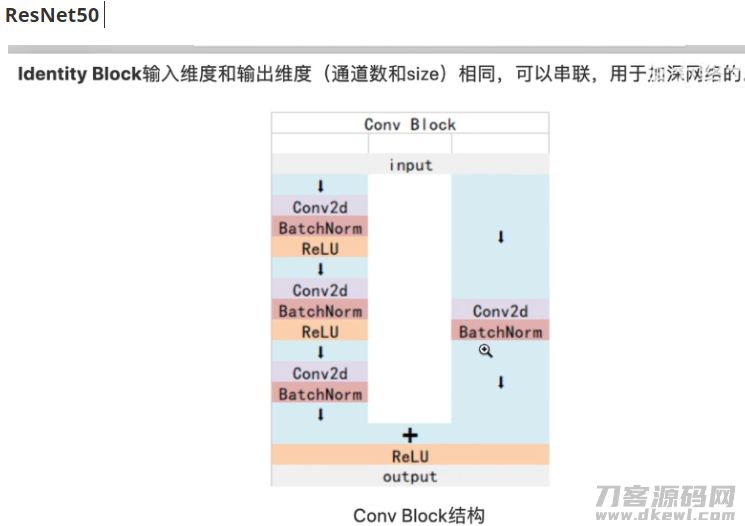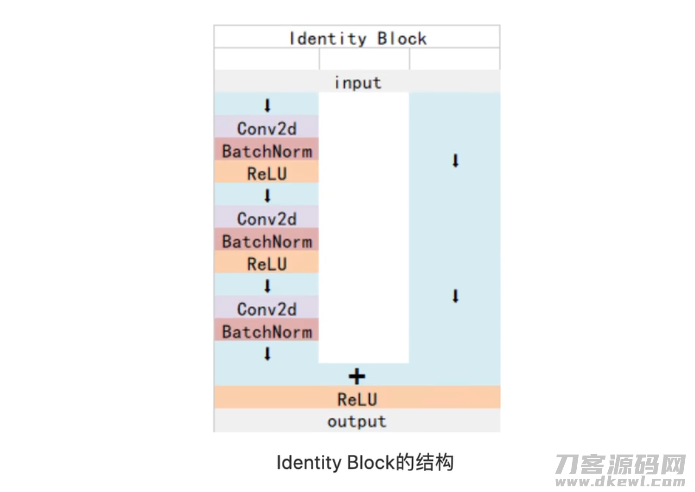摘要
Conv3D是TensorFlow中的一个神奇函数,它可以帮助我们进行三维卷积操作。它有很多参数,比如卷积核大小、步长、填充方式等等。使用这个函数,我们可以轻松地构建出一个强大的卷积神经网络,让我们的模型更加准确、高效!
正文
TensorFlow 之 keras.layers.Conv3D( ) 基本参数解读
keras.layers.Conv3D( ) 函数调用
def __init__(self, filters,
kernel_size,
strides=(1, 1),
padding='valid',
data_format=None,
dilation_rate=(1, 1),
activation=None,
use_bias=True,
kernel_initializer='glorot_uniform',
bias_initializer='zeros',
kernel_regularizer=None,
bias_regularizer=None,
activity_regularizer=None,
kernel_constraint=None,
bias_constraint=None,
**kwargs):
主要参数:
filters 全连接层数量的转变,filters 危害的是最终键入結果的的第三个层面的转变,比如,键入的层面是 (600, 600, 3), filters 的数量是 64,变化后的层面是 (600, 600, 64)
>>> from keras.layers import (Input, Reshape)
>>> input = Input(shape=(600, 600, 3))
>>> x = Conv3D(64, (1, 1), strides=(1, 1), name='conv1')(input)
>>> x
<tf.Tensor 'conv1_1/BiasAdd:0' shape=(?, 600, 600, 64) dtype=float32>
kernel_size 主要参数 表明全连接层的尺寸,能够立即写一个数,危害的是輸出結果前2个数据信息的层面,比如,(600, 600, 3)=> (599, 599, 64)
>>> from keras.layers import (Input, Conv3D)
>>> input = Input(shape=(600, 600, 3))
>>> Conv3D(64, (2, 2), strides=(1, 1), name='conv1')(input)
<tf.Tensor 'conv1/BiasAdd:0' shape=(?, 599, 599, 64) dtype=float32>
立即写 2 也是能够的
>>> from keras.layers import (Input, Conv3D)
>>> input = Input(shape=(600, 600, 3))
>>> Conv3D(64, 2, strides=(1, 1), name='conv1')(input)
<tf.Tensor 'conv1_2/BiasAdd:0' shape=(?, 599, 599, 64) dtype=float32>
strides 步幅 一样会危害輸出的前2个层面,比如,(600, 600, 3)=> (300, 300, 64),特别注意的是,括弧里的数据信息能够不一致,各自操纵横坐标轴和纵轴,这儿步幅的计算方法为:
>>> from keras.layers import (Input, Conv3D)
>>> input = Input(shape=(600, 600, 3))
>>> Conv3D(64, 1, strides=(2, 2), name='conv1')(input)
<tf.Tensor 'conv1_4/BiasAdd:0' shape=(?, 300, 300, 64) dtype=float32>
padding 是不是对周边开展添充,“same” 即便 根据kernel_size 变小了层面,可是四周会添充 0,维持原来的层面;“valid”表明储存不以0的合理信息内容。好几个比照实际效果以下:
>>> Conv3D(64, 1, strides=(2, 2), padding="same", name='conv1')(input)
<tf.Tensor 'conv1_6/BiasAdd:0' shape=(?, 300, 300, 64) dtype=float32>
>>> Conv3D(64, 3, strides=(2, 2), padding="same", name='conv1')(input)
<tf.Tensor 'conv1_7/BiasAdd:0' shape=(?, 300, 300, 64) dtype=float32>
>>> Conv3D(64, 3, strides=(1, 1), padding="same", name='conv1')(input)
<tf.Tensor 'conv1_8/BiasAdd:0' shape=(?, 600, 600, 64) dtype=float32>
>>> Conv3D(64, 3, strides=(1, 1), padding="valid", name='conv1')(input)
<tf.Tensor 'conv1_9/BiasAdd:0' shape=(?, 598, 598, 64) dtype=float32>
根据这类非常简单的方法,能够观查 ResNet50 的构成构造

Conv Block 的构架:
def conv_block(input_tensor, kernel_size, filters, stage, block, strides):
filters1, filters2, filters3 = filters # filters1 64, filters3 256 将标值传到到filters。。。中
conv_name_base = 'res' str(stage) block '_branch'
bn_name_base = 'bn' str(stage) block '_branch'
x = Conv3D(filters1, (1, 1), strides=strides, name=conv_name_base '2a')(input_tensor)
x = BatchNormalization(name=bn_name_base '2a')(x)
x = Activation('relu')(x)
x = Conv3D(filters2, kernel_size, padding='same', name=conv_name_base '6b')(x)
x = BatchNormalization(name=bn_name_base '6b')(x)
x = Activation('relu')(x)
x = Conv3D(filters3, (1, 1), name=conv_name_base '2c')(x)
x = BatchNormalization(name=bn_name_base '2c')(x)
shortcut = Conv3D(filters3, (1, 1), strides=strides, name=conv_name_base '1')(input_tensor)
shortcut = BatchNormalization(name=bn_name_base '1')(shortcut)
x = layers.add([x, shortcut])
x = Activation("relu")(x)
return x
Identity Block 的构架:

def identity_block(input_tensor, kernel_size, filters, stage, block):
filters1, filters2, filters3 = filters
conv_name_base = 'res' str(stage) block '_branch'
bn_name_base = 'bn' str(stage) block '_branch'
x = Conv3D(filters1, (1, 1), name=conv_name_base '2a')(input_tensor)
x = BatchNormalization(name=bn_name_base '2a')(x)
x = Activation('relu')(x)
x = Conv3D(filters2, kernel_size, padding='same', name=conv_name_base '6b')(input_tensor)
x = BatchNormalization(name=bn_name_base '6b')(x)
x = Activation('relu')(x)
x = Conv3D(filters3, (1, 1), name=conv_name_base '2c')(input_tensor)
x = BatchNormalization(name=bn_name_base '2c')(x)
x = layers.add([x, input_tensor])
x = Activation('relu')(x)
return x
最终是总体构架:
def ResNet50(inputs):
#-----------------------------------#
# 假定键入进去的照片是600,600,3
#-----------------------------------#
img_input = inputs
# 600,600,3 -> 300,300,64
x = ZeroPadding3D((3, 3))(img_input)
x = Conv3D(64, (7, 7), strides=(2, 2), name='conv1')(x)
x = BatchNormalization(name='bn_conv1')(x)
x = Activation('relu')(x)
# 300,300,64 -> 150,150,64
x = MaxPooling3D((3, 3), strides=(2, 2), padding="same")(x)
# 150,150,64 -> 150,150,256
x = conv_block(x, 3, [64, 64, 256], stage=2, block='a', strides=(1, 1))
x = identity_block(x, 3, [64, 64, 256], stage=2, block='b')
x = identity_block(x, 3, [64, 64, 256], stage=2, block='c')
# 150,150,256 -> 75,75,512
x = conv_block(x, 3, [128, 128, 512], stage=3, block='a')
x = identity_block(x, 3, [128, 128, 512], stage=3, block='b')
x = identity_block(x, 3, [128, 128, 512], stage=3, block='c')
x = identity_block(x, 3, [128, 128, 512], stage=3, block='d')
# 75,75,512 -> 38,38,1024
x = conv_block(x, 3, [256, 256, 1024], stage=4, block='a')
x = identity_block(x, 3, [256, 256, 1024], stage=4, block='b')
x = identity_block(x, 3, [256, 256, 1024], stage=4, block='c')
x = identity_block(x, 3, [256, 256, 1024], stage=4, block='d')
x = identity_block(x, 3, [256, 256, 1024], stage=4, block='e')
x = identity_block(x, 3, [256, 256, 1024], stage=4, block='f')
# 最后得到一个38,38,1024的共享资源特点层
return x
另附基础理论连接 Resnet-50网络架构详细说明 https://www.cnblogs.com/qianchaomoon/p/12315906.html
关注不迷路
扫码下方二维码,关注宇凡盒子公众号,免费获取最新技术内幕!








评论0